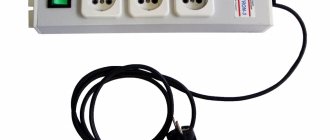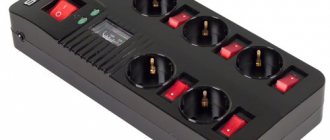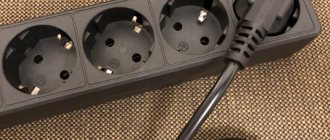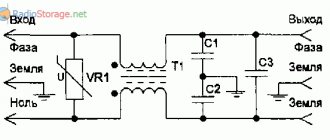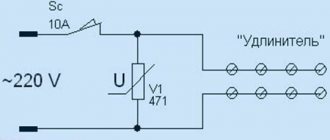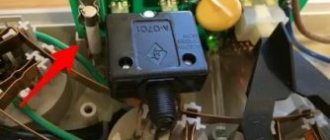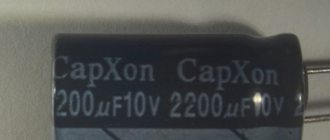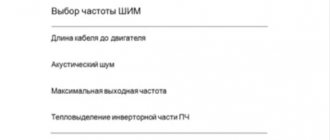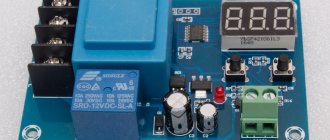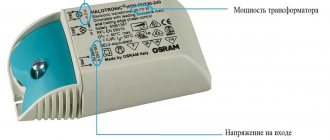What to do when the TV or refrigerator is installed 2-3 meters from the outlet? This distance is not critical, because you can take an extension cord with a cord of the required size and easily connect the equipment to the power supply.
Many users call an extension cord and a surge protector, without particularly delving into the functionality of both devices. Is there a difference between them and what are the features of each item? The article will tell you what it is, why it is needed, and how a surge protector differs from an extension cord. The material will be useful to anyone who is interested in the nuances of using electrical appliances (laptops, refrigerators, etc.).
If you suddenly need a refrigerator, read: TOP 10 best budget refrigerators
What is a surge protector and why is it needed?
The reasons for the failure of computers and other sensitive equipment are voltage surges and distortion of the frequency of electric current. A surge filter is a noise suppression device that automatically disconnects devices from the network or smoothes out a voltage sinusoid that is broken from interference.
Inside the surge protector that controls the voltage, there are varistors, capacitors, fuses and other parts to protect electrical appliances. The main parameter on which the quality of the SF operation depends is the response time. A high-quality device responds in a timely manner to lightning strikes and other network problems.
Conditions for full operation of the protective device
The purchase of a device is necessary to protect an electrical appliance from short circuits due to a broken wire or malfunction of any gadget. The correct choice will ensure the operation of electronics equipped with specific power supplies. The latest developments will eliminate inductive interference, voltage surges and provide charging for gadgets with a built-in USB port.
Take into account:
- Number and type of sockets - with contact plates or Eurotype for round pins.
- Availability of a computer plug for direct connection to a constant power source. Connection via a UPS provides excellent protection for PC equipment.
- The maximum power is indicated in amperes - its value is obtained by multiplying the indicated amount by the standard network voltage. Here you need to focus on the total power of the equipment: if it is higher than this indicator, the filter will turn off the devices.
- Level of protection - basic, advanced or professional. The second is the most popular, the cost is relatively budget. The third is more expensive, although experts are confident that it will quickly pay for itself.
- Most surge protectors suppress short-term voltage surges, but are powerless against long-term increases.
- Interference suppression and overheat shutdown are two other important points. Almost everyone has suppression, and shutdown when overheating occurs only if there is a special sensor.
- Type of switch: with several individual keys, a common wide button or even a remote control - a convenient option for the lazy or disabled.
- The cable length is variable - you need to accurately determine the required value, otherwise you can get confused in the excess or waste current in folded loops.
These are not all the features that real experts pay attention to. A non-professional can choose a device with the functions necessary in a particular situation.
Additional aspects
Manufacturers will improve the shortcomings of models that are discovered during purchase or indicated in reviews.
Examples:
- indicator light, usually combined with the power key;
- USB port;
- special mounts - on the wall or for wires, if a significant number of them are connected.
Sometimes expensive models have other interesting features. There is no need to skimp on the device - it ensures the safety of expensive gadgets.
Types of models
- Basic devices. Consists of a fuse and basic low-cost components. Protect equipment from surges and short circuits.
- Advanced options. Smoothes out interference in the electrical network. These are middle-class devices that are used for home appliances.
- Professional devices. Used for ultra-sensitive electronics.
Individual or general switches are installed on the SF. Expensive models come with remote controls. A surge protector with USB is purchased to connect gadgets to the network without a charger. There are devices that are equipped with fastenings for wires, shutdown indicators, and wall mounts. The length of a typical surge protector cable is from 1 to 10 meters.
General characteristics
The devices are similar primarily in form factor , which is why they are often confused with each other. Made in the form of a compact case with a socket splitter, a wire with 3 cores, and a plug. Extension cords equipped with a switch button are especially often confused with filters. In fact, there are no additional components in them besides the switch.
Can be used for the same purposes:
- Increasing the length of the electrical appliance wire.
- Connecting several devices simultaneously.
In fact, every surge protector duplicates the functions of any extension cord. But this rule does not work in the opposite direction, since simple extension cords do not have filtering capabilities.
Regulatory requirements
When purchasing, make sure that the 220V surge protector is included with a passport, technical description, and operating instructions.
Basic technical requirements:
| Parameter | Meaning |
| Operating voltage | 220-230 V |
| Operating frequency | 50, 400 Hz |
| Bus voltage drop | Up to 2% |
| Ratio of cutoff frequency to natural resonant frequency | Up to 2 times |
| Nonlinear distortion | Up to 0.5% |
| Maximum case heating temperature at an ambient temperature of 25 degrees | Up to 60 degrees |
| Life time | From 10 years |
| Recovery time | Up to 60 minutes |
| Upper value of operating temperature of elements | +60 degrees |
| Rated voltage for which capacitors are designed | From 1.8 normal parameters |
Differences between a filter and a regular extension cord
A board is built into filtering devices to contain voltage surges. A surge protector and a regular extension cord are different devices. They are connected only by a block with sockets and a cable. The main requirement for surge protectors with grounding is the presence of a circuit. Extension cords with one capacitor are often sold under their guise. The part is capable of absorbing a small percentage of impulses. But with strong jumps this does not save the technique.
For an iron, kettle or simple vacuum cleaner, a surge protector with switches is not needed; this equipment is not considered sensitive. The device is necessary for connecting laptops, PCs, cinemas, refrigerators and music centers. The cost of a surge protector for a computer or TV starts from 2,000 rubles. Therefore, the obvious difference from an extension cord without protection is the price.
The surge protector protects equipment from power surges, short circuits, and overheating. The model is selected depending on the type of electronics. Devices are subject to requirements for safe operation. They are structurally different from a simple extension cord.
Household approach to surge protectors
Just some eight to ten years ago, a surge protector, in the eyes of the majority of our fellow citizens, was exclusively a computer attribute. In those days, when purchasing such a device, the buyer studied its technical characteristics for a long time and carefully in order to choose the truly best one offered by sellers. At the same time, not much attention was paid to the appearance of the product, partly due to the fact that in those days most surge protectors looked almost the same. But, times are changing. And today, surge protectors are not at all an exclusively computer attribute, but have become a common and familiar household device. The modern buyer is no longer as attentive and picky about purely technical characteristics as he used to be. In addition, surge protectors in everyday life are mostly considered as extension cords with a bunch of output connectors and a switch, rather than as a serious device for filtering the supply voltage. Accordingly, the buyer’s main attention is focused on such parameters of the purchased product as ease of use, appearance, and functional equipment. It is from this point of view, in this material, that six network filters will be considered. I hope that this will help some people broaden their horizons and see that not all filters are the same and are just “a piece of wire with a box of connectors hanging on the end.”
Pilot-S
According to the manufacturer, Pilot-S is a cost-effective solution for protecting office electronics. In fact, the only thing this filter will do well is protect the user’s network from possible short circuits in the power circuits of the equipment connected to it.
The filter in question is primitive both outside and inside. The network cable, whose length is 1.78 m, ends in a simple, without any frills, case (size 373x47x46 mm). In turn, the case carries an illuminated power switch, a fuse reset button, and six connectors for connecting consumers. Five of them are quite modern, that is, with grounding. The sixth connector is without grounding and is made for compatibility with old-style plugs. All connectors are located almost close to each other, which is why the user may experience some problems. I mean the case when the equipment is powered by an external power supply whose dimensions, most often, exceed the dimensions of a conventional power plug.
Accordingly, when connecting such a power supply, the user will not be able to use the connector adjacent to it. In addition to this, the Pilot-S connectors do not have the so-called “child protection”. By the way, a child can also disassemble the housing of the filter in question without any problems. To do this, he doesn’t even need a Phillips screwdriver, because the case covers are fastened with ordinary furniture screws, the heads of which almost protrude beyond the boundaries of the case. Only one of them is recessed so that a plasticine seal, made in the best traditions of electrical instrument making of Soviet times, could be placed on top of it.
I hope that you can still convince your child that there is absolutely nothing inside the filter that deserves even a drop of attention. Actually, this is actually true, because in addition to the switch and fuses, the filter consists of one single container. We are not comparing the characteristics of filters now, but I think it’s not difficult to imagine how “serious” such a filter is.
I hope you have already sufficiently appreciated the Pilot-S in question. And, in my opinion, the last thing left to consider is the possibility of attaching this filter somewhere. For this purpose, its design includes two ears with holes. Unfortunately, the shape of these holes does not allow hanging the filter housing on an existing screw, for example, in the wall. That is, to attach the Pilot-S to any surface, you must first install it at the mounting location and only then secure it with a screw, screw, or whatever you will secure it with. The design of the case does not provide for any other options, which is sad.
Pilot-GL
This model is no longer as economical as the Pilot-S discussed above. The electrical circuit has become more serious and has grown to the LC filter that has already become traditional in such devices. True, the manufacturer still managed to save money. Instead of six output connectors, as was the case with the Pilot-S filter, in this case we have only five. Four of them are with grounding and one is without it. But, compared to the younger model, the location of the Pilot-GL connectors is more convenient for the user, since the universal connector (the one that does not have a ground) is spaced 11mm away from the others. Of course, not much, but if you include not very large external power supplies for the equipment, then the adjacent outlet will still remain accessible to the user.
Compared to the previous model, the Pilot-GL has improved not only the electrical circuit of the filter, but also the display. So, in addition to the backlit power switch, the Pilot-GL additionally has a green LED. It lights up if everything is in order with the device. If, as a result of an overload or short circuit in the filter, the protection is triggered, the LED will go out. At the same time, the power switch will continue to light, indicating the presence of voltage at the Pilot-GL input. I must say that this function sometimes turns out to be very useful.
This, in general, is where all the positive differences between the Pilot-GL and its younger brother end. Everything else, unfortunately, migrated from the younger model to the older one without any changes for the better. The network cable remained the same length (1.78m). The output connectors are not childproof. The covers of the device body are tightened with exactly the same screws as in the Pilot-S. True, there are two more ears for attaching the filter. But, the holes in them, just like in the Pilot-S, do not allow you to hang the filter housing on a screw or screw that is already screwed into, for example, a wall. In general, in my opinion, Pilot-GL is certainly better than the simpler model described earlier. But final conclusions are still far away, and therefore let’s move on to considering the next filter.
Pilot-Pro
This is the top model in the Pilot line of surge protectors. It would seem that it should combine all the best that was in the younger models. But, unfortunately, in addition to this, Pilot-PRO also inherited some of the disadvantages of the Pilot-S and Pilot-GL described above. These include the absence of “child protection” on the output connectors and furniture screws that tighten the housing covers. In addition, the device’s network cable (length 1.76 m) is for some reason two centimeters shorter than that of younger models. It seems like a small thing and cannot be called a serious drawback, but I expected that the Pilot-PRO cable would be at least no shorter than the Pilot-S and Pilot-GL cable.
It seems that the shortcomings have been sorted out and now we can consider the advantages. They consist of the advantages of the two filters described earlier and, in addition, their own. So, in this case, similar to the Pilot-S model, the user receives six output connectors for connecting various equipment. One of these connectors does not have a ground connection, allowing you to use older style plugs. Like the Pilot-GL filter, in the Pilot-PRO this connector is spaced 11mm apart from the other five. Accordingly, you can plug in external power supplies without losing the ability to use the connector adjacent to it.
The display in Pilot-PRO is implemented similarly to the younger, in comparison to it, model Pilot-GL. That is, in addition to the illuminated power switch, there is an LED installed on the top cover of the filter housing. If the filter is turned on and everything is in order, the LED will light up. If the overload or short circuit protection has tripped, then only the power switch will light up.
As for the design of the Pilot-PRO, from an aesthetic point of view it is much superior to the design of the filters described previously. And not only from an aesthetic point of view. This model introduced solutions that are also useful from the point of view of practical operation of the filter. Thus, the device comes complete with a plastic casing that is attached to it. It is designed for laying cables stretched from the filter to the connected equipment. I must say that this accessory is really very useful. This will be especially appreciated by those who will hang Pilot-PRO on the wall.
And the last thing left to say concerns exactly what I mentioned just above. That is, about hanging the filter, for example, on the wall. For these purposes, two holes are provided on the bottom cover of the filter housing. Unlike the Pilot-S and Pilot-GL described above, the filter in question can be hung and, if necessary, quickly removed. True, it can only be hung in one horizontal position. But, you see, this is already good.
Summing up the interim results, I would like to say the following: The only significant advantage of Pilot filters today is that they are easily accessible to the buyer. They can be bought on almost every corner, in almost any household appliance or even household goods store. In my opinion, these filters are no longer attractive in any other way. The case design is old-fashioned and, except for the Pilot-PRO model, not that attractive. Not a single model has protection for output connectors from children's pranks. The freedom to place filters on a wall or other steep surfaces is limited by the design features of the housings. But, I repeat once again, products under the Pilot brand are easily available, and the brand itself has been well known to our customers for a long time. What can be opposed to this fame? Naturally, something, since we are talking about opposition, in some of its parameters is not inferior to the considered filter models. Even if this something is not so accessible and you will have to go to a specialized store to purchase it. The market situation is changing quickly and maybe tomorrow everything will change in favor of another brand. And it is also quite possible that this brand will become Defender. It is for this reason that, further, I begin to describe and compare some models of surge protectors from Defender. Naturally, I will compare them both with each other and with filters from Pilot.
Defender DFS 401
The Defender DFS 401 under review is somewhat similar in appearance to the Pilot-S filter described above. Fortunately, the similarity is only superficial and only partial. Actually, it is contained in the shape of the housing and the number of output connectors for connecting electricity consumers. In all other respects, these filters differ very much.
Let's start with the fact that, unlike Pilot filters, Defender DFS 401 has all output connectors with grounding. Accordingly, the user will not be able to connect devices equipped with old-style plugs to the filter. But, on the other hand, all output connectors are equipped with “child protection”. So, your child will not be able to stick two nails into them, with all the ensuing consequences. Similarly with the Pilot-GL and Pilot-PRO filters, one of the Defender DFS 401 output connectors is separated from the other five by a very significant distance of 29mm. It follows that this filter is better suited for connecting large external power supplies to equipment than filters from Pilot.
As you remember, the Pilot filter power switches were backlit. But in the Defender DFS 401 filter, the switch key, although made of transparent red plastic, is not backlit. To indicate the status of the filter, two LEDs are installed on its top cover. The indication itself is similar to that used in the Pilot-GL and Pilot-PRO filters. That is, the Power OK LED lights up when there is input voltage, and the Protected LED lights up when there is voltage at the filter output connectors. If the overload or short circuit protection has tripped, the Protected LED goes out.
I have already written about the presence of “child protection” on the output connectors of the Defender DFS 401. But, from a safety point of view, this is not the only advantage of this filter. Your children will also not be able to open the device case and thereby expose themselves to the danger of electric shock. The fact is that the heads of the screws that secure the housing covers are completely smooth. That is, opening the filter housing, especially at home, is not expected at all. Of course, you can open the device case if you simply drill out the screws. But, you yourself understand that after such a procedure you can forget about warranty repair of the filter. For those who are very curious about the contents of the Defender DFS 401 case, I present a photo of its printed circuit board with LEDs, an LC filter, and vacuum arresters placed on it.
What else is left to say when describing the Defender DFS 401? I’m thinking about the case when the user, having connected the filter, wants to hang it on a vertical surface or simply secure it anywhere. Here the Defender filter is doing much better than the previously reviewed Pilot filters. For hanging or fastening, appropriate holes are provided on the bottom cover of the device body. The holes are made cross-shaped, so the filter can be hung on a screw already screwed in somewhere, positioning it the way you like. In this regard, Defender DFS 401 has clear advantages over any of the Pilot filters. And in terms of the length of its network cable (1.98 m), although it is not much, it is still ahead of its competitors.
Defender DFS Pro
At its core, Defender DFS PRO is an upgrade of the Defender DFS 401 filter described above. He got a lot from DFS 401. These include child-proof output connectors, a power switch with LED indicators, cross-shaped holes on the bottom cover of the case for attaching the filter, self-tapping screws with a completely straight head that tighten the case, and the electrical circuit of the LC filter, and even the length of the network cable (1.98 m). So what has undergone modernization? Based on what I have listed, it is not difficult to guess that this is a body.
Indeed, we have before us a DFS 401 with a modernized case and, thanks to this, an increased number of output connectors. The DFS PRO case is slightly shorter and wider than the DFS 401 case. On its top cover, in addition to the power switch and LED indicators, there are as many as seven output connectors. All of them are grounded, so users will not be able to use equipment whose network cables are equipped with old-style plugs. But DFS PRO is perfect for those who need to connect several large external power supplies for equipment. For this purpose, the filter in question has two output connectors spaced 21mm from the remaining five connectors and 28mm from each other. This, in fact, is where the differences between DFS 401 and the DFS PRO under consideration end.
Defender DFS 801
No, unlike the previous filter, this is not a modernization at all. Although, the dimensions and shape of the Defender DFS 801 and Defender DFS PRO cases are completely the same. Everything else is completely different. Even the DFS 801 network cable (length 2.0m) is 2cm longer than that of the DFS PRO.
And so, we have before us the top model of the Defender filter family. Its striking distinctive feature is the ability to control its output connectors. There are six of these connectors in total. Of these, one is a manager, and the remaining five, respectively, are managed. So, what is this, one might say, smart device and how does it work?
First of all, it should be said that the DFS 801 does not have a power switch. What can be mistaken for it in the photo is actually a switch for the operating modes of the slave output connectors. Therefore, there is only one way to completely turn off the filter - by disconnecting from the source from which the filter is powered. If there is input voltage, at least one (control) output connector is always energized.
There are two options for operating the DFS 801. The first is to use it as a regular surge protector, with the only difference being that most conventional filters have a power switch. In order to use the DFS 801 so simply, the user just needs to set the filter operating mode switch, located on the top cover of the housing, to the Manual position. After this, if everything is in order with the filter, the red Slave ON LED should light up. This filter indicates that the five Slave output connectors are energized. After this, you can connect any equipment to the filter, almost like a regular surge protector. Why almost? But because the output connectors of the DFS 801 are slightly different. If the total load capacity of the slave connectors is 10A, as with most conventional filters, then the maximum load of the control (Master) connector is much less. It is only 2.5A. Therefore, the user must be careful when connecting consumers and not allow powerful electrical appliances to be connected to the control connector.
The second operating mode of Defender DFS 801 is much more interesting than described above. The fact is that a current relay with an adjustable response threshold is installed in the filter control output connector circuit. This relay, as you might guess, controls the slave output connectors. Let's assume that you want to connect your PC and all its peripherals to the filter. At the same time, you want the PC to control turning on/off this very peripheral. To do this, use the appropriate switch to switch the Defender DFS 801 to Auto mode.
In this case, the plugs of the peripheral network cables must be plugged into the slave output connectors, and the cable plug of the PC system unit, respectively, into the control (Master) connector. After this, all you have to do is adjust the operating threshold of the current relay. For this purpose, there is a corresponding regulator on the side wall of the filter housing. By rotating it, ensure that power is supplied to the filter output connectors only when the PC system unit is turned on. This is where all filter adjustment ends.
Perhaps the most interesting thing about Defender DFS 801 has already been written. Of course, this is the best model among those described in this material. She has only one drawback. Unfortunately, only one output connector is located far enough from its neighbors. But, despite the fact that it is a manager, the user most likely will not be able to use it for external power supplies of equipment.
Accordingly, we can conclude that the reviewed Defender DFS 801 is far from being the best suited for cases where the use of specified power supplies is necessary. In this way, unfortunately, it is generally similar to the Pilot-S filter, described at the very beginning of this material. As for safety and the ability to mount the filter on walls and other surfaces, the DFS 801 is similar to the Defender filters described above.
What can we say after describing three more network filters? I think it’s fair enough to say that Defender filters don’t fully have everything you want. What is missing? In my opinion, at least there are no grounded output connectors that are compatible with the old style plugs. None of the Defender filter models have them, while such connectors are still relevant in everyday life. Also, I personally wouldn’t mind using casings for routing network cables, like the one included in the Pilot-PRO filter kit. Otherwise, Defender can be considered quite modern devices that almost completely satisfy the needs of a wide range of users.
I suppose that after this description of surge protectors, you will get the opinion that it is simply not fair to compare Pilot and Defender. Just as, for example, it is not fair to compare a rowing boat with a speedboat. However, in my opinion, this is not the case! Yes, it seems that Pilot filters are in many ways inferior to Defender filters. But, you see, the Pilot is the dominant one on sale right now. Therefore, I consider it quite acceptable to consider them in the same material with filters from another manufacturer. After all, not everything is the best that can be bought on every corner.
